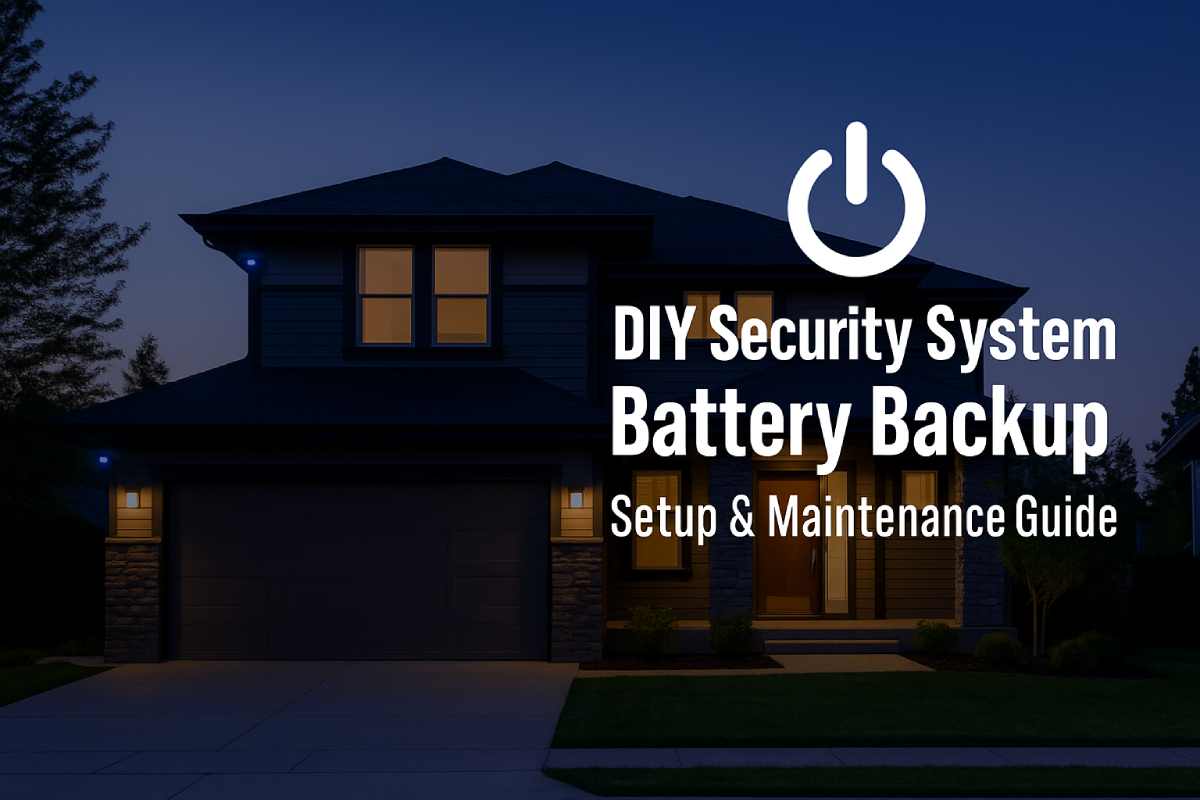A dedicated battery backup is essential for any DIY security system because it guarantees continuous operation of sensors, cameras, and alarms when the power goes out, preventing critical blind spots during emergencies.
Without a reliable backup, even a brief AC outage can instantly disable monitoring, leaving homes vulnerable during storms, grid failures, or unexpected blackouts.
Installing a deep-cycle or sealed lead-acid battery with a proper inverter and charge controller ensures seamless switchover to battery power, maintaining real-time alerts and notifications throughout extended outages.
Regular testing and maintenance—such as quarterly voltage checks and capacity tests—extend battery lifespan and help you avoid failures that trigger false alarms or leave your system offline when you need it most.
By integrating a dedicated battery backup into your DIY setup, you fortify your security infrastructure against power interruptions and gain true peace of mind with uninterrupted home defense 24/7.
Benefits of a Battery Backup
A robust battery backup for DIY security systems ensures continuous monitoring even when the grid goes down, providing 4–24 hours of runtime on average and up to 48–72 hours with extended multi-battery setups, thereby eliminating coverage gaps during storms or outages.
Moreover, many insurers reward properties equipped with backup power solutions through premium discounts ranging from 2–20 percent, and resilient backup systems can boost home valuations by $5,000–$10,000 in areas prone to blackouts.
Continuous Protection
When AC power fails, a dedicated battery backup instantly takes over, keeping sensors, cameras, and control panels fully operational so you never miss a critical event.
This seamless switchover is vital during severe weather, grid outages, or transformer failures, ensuring your DIY system continues to detect intrusions and trigger alarms without interruption.
Even basic alarm systems typically promise 4–24 hours of backup, while professional-grade setups often exceed 24 hours, delivering peace of mind when it matters most.
| System Type | Backup Duration Range |
|---|---|
| Standard Alarm Panels | 4–24 hours |
| ADT Smart Home Hub & Base | 24 hours |
| Multi-Battery SLA Configurations | 48–72 hours |
Insurance & Peace of Mind
Insurance providers recognize that reliable power redundancy dramatically reduces loss risk from fire, theft, or system downtime. As a result, homeowners can unlock discounts of 5–20 percent off their premiums by installing monitored security systems with battery backup.
Discounts vary by insurer—ranging from 2 percent at some carriers to 15–20 percent at others—so it pays to shop around and present certification of your backup installation.
Beyond premiums, properties equipped with resilient backup systems often command $5,000–$10,000 higher resale values in markets prone to outages, as buyers increasingly prioritize uninterrupted security and power independence.
| Insurance Provider | Typical Discount | Notes |
|---|---|---|
| Insurify | Up to 20 % | Discount varies by system type and location |
| BrokerLink | 5–20 % | Depends on monitoring level and professional installation |
| RBC Insurance | 2–15 % | For centrally monitored fire & theft systems |
| FCIQ | 5–20 % | Based on policy and plan specifics |
By combining uninterrupted protection with tangible financial benefits—lower premiums and enhanced property value—a dedicated battery backup transforms a DIY security setup into a true asset for long-term safety and investment.
Key Components & Tools
A reliable battery backup hinges on choosing the right battery chemistry, power conversion components, and having the proper tools on hand.
Deep-cycle batteries deliver sustained energy through ≈2,000 full discharge/recharge cycles, making them ideal for long runtimes, while sealed lead-acid (VRLA) types like AGM or gel offer maintenance-free operation but typically endure 50–100 full-depth cycles and last 3–7 years in real-world use.
Inverters translate stored DC power into the AC voltage your security panel and cameras need, often cutting off at around 11.5 V to protect the battery from deep discharge.
Charge controllers safeguard against overcharge and reverse current, using PWM or MPPT technology to optimize charging efficiency and prolong battery life.
Lastly, preparing for installation requires essential tools—from a multimeter for voltage checks to inline fuse holders, quality wiring, and OSHA-compliant PPE—to ensure a safe, code-compliant setup.
Battery Types
| Feature | Deep-Cycle Battery | Sealed Lead-Acid (VRLA) |
|---|---|---|
| Cycle Life | ~2,000 full discharge/recharge cycles versus ~200 for starter batteries | 50–100 cycles at 100% DoD; 500 cycles at 40% DoD |
| Lifespan | 300–1,000 cycles at ~50% DoD; up to 8 years with proper maintenance | Generally 3–7 years under normal use patterns |
| Cost | $150–$300 for a 100 Ah Group 31 deep-cycle lead-acid battery | $120–$200 for a 65 Ah AGM VRLA battery (varies by brand/type) |
| Maintenance | Requires periodic watering and terminal cleaning to prevent sulfation | Maintenance-free design; requires only regular functional testing and cleaning |
Inverter & Charge Controller
- Inverter Role: Converts DC battery voltage into AC power for security panels, cameras, and auxiliary devices.
- Low-Voltage Cutoff: Built-in shutdown (around 11.5 V) prevents deep discharge that can shorten battery lifespan.
- Charge Controller Role: Regulates charging current to block reverse flow at night and prevent overcharging, using semiconductors or relays as “valves” for one-way current.
- PWM vs. MPPT: PWM controllers offer basic regulation, while MPPT units track the solar panel’s maximum power point, boosting charging efficiency by up to 30%.
Installation Tools
- Multimeter: For measuring voltage, current, and continuity to verify correct wiring and battery health.
- Wiring & Cable: Use 4-core alarm cable or appropriately gauged power and signal wires to connect batteries, inverter, and security devices.
- Fuse Holders & Fuses: Inline fuse holders with correctly rated fuses safeguard against short-circuits and overloads.
- General Tools: Screwdrivers (flat & Phillips), wire strippers, hole saw, battery-powered drill with bits, level, and fish tape (glow rod) for routing cables.
- PPE: Insulated gloves, safety glasses, and hearing protection per OSHA electrical safety standards to minimize risk during installation
Calculating Power Requirements
Accurate battery sizing for a DIY security system begins with a load analysis—itemizing the wattage of each camera, sensor, and NVR, then converting that total into amp-hours (Ah) at your backup voltage.
Using the core relations Power (W) = Voltage (V) × Current (A) and Time (h) = Capacity (Ah) / Current (A), you can derive a first-pass runtime.
For real-world planning, adjust for inverter and wiring inefficiencies (≈10–15 %) and restrict depth-of-discharge to 50–80 % to preserve battery health. The sections below walk through these calculations step by step.
Load Analysis
To perform a load analysis, start by listing each device’s power rating in watts (W) from manufacturer datasheets or adapter labels.
Convert each device’s wattage to current in amps (A) at your backup voltage (typically 12 V) using: Current (A) = Power (W) / Voltage (V) Sum all device currents to determine the total draw on your battery bank.
Finally, compute the amp-hour requirement by multiplying total current by desired backup duration in hours: Required Ah = Total Current (A) × Backup Time (h)
| Device | Power (W) | Voltage (V) | Current (A) = W ÷ V | Quantity | Total Current (A) |
|---|---|---|---|---|---|
| Bullet Camera | 4 | 12 | 0.33 | 4 | 1.33 |
| Passive Infrared Sensor | 0.5 | 12 | 0.04 | 5 | 0.21 |
| NVR Recorder | 15 | 12 | 1.25 | 1 | 1.25 |
| Total | — | — | — | — | 2.79 A |
Example above shows a 4-camera setup with sensors and NVR, drawing 2.79 A total
Runtime Estimates
Using the basic formula: Time (h) = Battery Capacity (Ah) / Load (A) a 100 Ah battery under a 2.79 A draw yields ≈35.8 hours of runtime.
To include inefficiencies from your inverter and cabling (η ≈ 0.85): Adjusted Time (h) = (Capacity (Ah) / Load (A)) × η
For battery longevity, limit depth-of-discharge (DoD) to about 80 %: Runtime (h) = (Capacity (Ah) × DoD) / Load (A)
| Formula | Description |
|---|---|
| Time = Capacity (Ah) / Load (A) | Basic runtime estimate |
| Time = (Capacity (Ah) × Voltage (V) × η) / Load (W) | Advanced—accounts for system efficiency |
| Runtime = (Capacity (Ah) × DoD) / Load (A) | Considers safe depth-of-discharge |
Example Calculation
For a 100 Ah, 12 V battery servicing a 33.48 W load (2.79 A × 12 V):
Backup Time =
(Battery Voltage × Capacity Ah)
÷ Load (W)
= (12 V × 100 Ah)
÷ 33.48 W
≈ 35.85 hours
Or via the basic amp-hour method:Time = 100 Ah / 2.79 A ≈ 35.8 hoursStep-by-Step Setup
Before you start wiring up your DIY security system battery backup, make safety your top priority by completely de-energizing the AC feed at the main breaker and verifying the absence of voltage with both a non-contact tester and a direct-contact multimeter per OSHA and NFPA 70E protocols.
Wear appropriate PPE—insulated rubber gloves rated for electrical work, acid-resistant gloves, safety glasses, and long sleeves—to protect against shocks and battery acid splashes.
Mount your deep-cycle or VRLA battery in a well-ventilated, dry location within three feet of your inverter or panel to minimize voltage drop.
Run marine-grade, PVC-insulated cable sized per Renogy’s AWG chart to keep voltage loss under 3 percent—e.g., 14 AWG for a 10 A load over 10 ft or 12 AWG for 15 A over 15 ft—and install a manual or automatic transfer switch beside your service panel to seamlessly switch between grid and battery power during outages.
Safety First
- Power down AC: Before touching any wiring, turn off the main breaker to isolate the AC feed. Confirm de-energization using a non-contact voltage tester (first check) followed by a multimeter set to AC volts for phase-to-phase and phase-to-ground testing, as required by OSHA 1910.137 and NFPA 70E.
- Wear PPE: Don insulated rubber gloves (rated ≥1,000 V), acid-resistant gloves, safety glasses, and long sleeves to guard against electric shock and battery acid exposure.
- Verify no live circuits: Always perform a two-step voltage test: start with a non-contact proximity tester, then follow up with a direct multimeter check to ensure safe work conditions.
| PPE Item | Purpose | Standard/Spec |
|---|---|---|
| Insulated rubber gloves | Protect against electric shock | OSHA 1910.137 |
| Safety glasses | Shield eyes from acid splashes | ANSI/ISEA 105 |
| Acid-resistant gloves | Guard hands from battery acid | General practice |
| Long-sleeve clothing | Skin protection from splashes | General safety |
Mounting & Wiring
- Placing the battery: Secure the battery on a non-conductive, ventilated shelf or bracket in a cool, dry area within three feet of your inverter or alarm panel.Tighten terminal bolts to manufacturer torque specs (typically 60–80 in-lb) to prevent loose-contact arcing.
- Routing cables: Use marine-grade, PVC-insulated battery cable rated for your system’s amperage. Follow Renogy’s cable size chart to limit voltage drop to under 3 percent. Secure cables at least every 12 inches with insulated clamps, avoid sharp bends, and keep them away from heat sources.
- Installing the transfer switch: Mount the manual or automatic transfer switch adjacent to your main service panel. Wire the switch’s input to the AC mains and its output to your inverter’s AC input following the manufacturer’s diagram. Set to “Auto” for seamless switchover when grid power fails.
| Current (A) | 0–10 ft Run | 10–20 ft Run |
|---|---|---|
| 0–5 | 16 AWG | 14 AWG |
| 5–10 | 14 AWG | 12 AWG |
| 10–15 | 12 AWG | 10 AWG |
With these steps—de-energizing circuits, equipping proper PPE, and methodically mounting and wiring your battery and transfer switch—you’ll establish a robust, code-compliant backup power solution for your DIY security system, ensuring uninterrupted protection even when the lights go out.
Initial Testing & Commissioning
Before relying on your DIY battery backup for critical home security, it’s vital to verify both the health of your backup battery and the system’s ability to switch seamlessly to battery power during an outage.
A proper Battery Health Check involves using a digital multimeter set to the correct DC range to measure static and charging voltages at the panel’s auxiliary terminals and directly on the battery, confirming readings of 12.6–12.7 V at rest and 13.2–13.8 V when charging
Many alarm panels also offer built-in diagnostics via their keypad or companion app, reporting battery impedance or charge percentage to catch aging cells before failure.
In the Simulated Outage test, you temporarily cut AC power—either by flipping the main breaker or unplugging a UPS—to ensure your system switches to battery in under one second, sustains monitoring functions (camera feeds, sensor polling, and notifications), and then returns to mains power and resumes charging without errors.
Documenting voltage and amperage before, during, and after these tests helps you track battery degradation over time and guarantees uninterrupted protection when real outages occur.
Battery Health Check
- Multimeter Setup: Set your meter to DC voltage above 20 V to safely measure a 12 V battery.
- Auxiliary Terminal Test: Place the red probe on the panel’s positive auxiliary output and the black probe on its negative terminal; expect 13.2–13.8 V with AC power present.
- Direct Battery Test: With the battery disconnected, measure directly on its terminals; you should see 12.6–12.7 V at rest, indicating a full charge.
- System-Reported Diagnostics: Use your alarm panel’s built-in battery test (often found under “System Diagnostics” or in the mobile app) to review parameters like impedance and estimated runtime.
| Battery State | Expected Voltage (V) | Test Location |
|---|---|---|
| Fully Rested | 12.6 – 12.7 | Battery terminals |
| Charging (AC Online) | 13.2 – 13.8 | Panel aux terminals |
| Under Load (No AC) | ≥12.0 | Panel aux or battery |
Simulated Outage
- Cut AC Power: Switch off the main breaker feeding your alarm panel or unplug the UPS to emulate a blackout.
- Verify Switchover Speed: The panel should shift to battery power in under 1 second, maintaining sensor polling, camera streaming, and alarm monitoring uninterrupted.
- Trigger Functional Tests: Open a door/window sensor or press “Test” on your panic button to confirm alarms still register, and notifications reach your phone or monitoring service.
- Restore Mains Power: Flip the breaker back or reconnect the UPS; the system should automatically revert to AC and show charging voltages of 13.2–13.8 V within minutes.
| Test Step | Action | Expected Result |
|---|---|---|
| 1. Emulate Outage | Turn off panel breaker or unplug UPS | System switches to battery in <1 s |
| 2. Functional Test | Open sensor or press panic | Alarm/signal sent and recorded |
| 3. Restore Power | Re-enable breaker or plug in UPS | System returns to mains and battery shows charging V |
Completing these initial tests not only confirms that your battery backup is healthy and capable of sustaining your DIY security system, but also builds confidence that your home remains protected in the event of real-world power failures.
Maintenance Schedule
Maintaining your security system’s battery backup guarantees that your home remains protected even when the lights go out.
A structured schedule of quarterly inspections combined with proactive battery replacement every 3–5 years helps prevent unexpected failures and extends the life of your backup power.
Quarterly Inspections
Conduct a comprehensive battery health inspection every three months using both your alarm panel’s diagnostics and manual measurements to catch early signs of degradation.
| Inspection Task | Description | Frequency |
|---|---|---|
| Voltage Measurement | Measure and record cell/unit voltages with a multimeter at rest and under charge | Quarterly |
| Internal Resistance Check | Use a battery cell tester to log internal ohmic values | Quarterly |
| Charger Function Test | Verify charger output (13.2–13.8 V) at panel auxiliary terminals | Quarterly |
| Visual & Temperature Inspection | Inspect for corrosion, swelling, leaks; record terminal temperatures | Quarterly |
Replacement Timeline
Sealed lead-acid backup batteries in most DIY alarm panels are rated for 3–5 years of reliable service, per manufacturer specifications.
Factors such as depth-of-discharge, temperature swings, and charging regimen can shorten lifespan, so planning for replacement between 3 and 5 years ensures you avoid sudden failures.
| Battery Model | Rated Life (Years) | Recommended Replacement Interval | Source |
|---|---|---|---|
| UltraTech IM-1272F1 (12 V 7 Ah SLA) | 3–5 | Every 3–4 years | |
| DSC BD4-12 (12 V 4 Ah SLA) | 3–5 | Every 3–5 years | (amazon.com) |
| Honeywell 1500 (12 V 3.2 Ah SLA) | 3–5 | Every 3 years | |
| FireLite MP-12/24 Replacement (7 Ah) | 3–5 | Every 4 years | (amazon.com) |
By adhering to quarterly health checks and swapping out batteries before they exceed their rated life, you’ll keep your DIY security system’s backup power in peak condition—delivering uninterrupted home protection and maximizing your investment.
Troubleshooting Common Issues
A reliable DIY security system relies on both seamless switchover to battery power and stable voltage under load.
Two primary issues often disrupt backup performance: Failure to Switch Over, usually caused by blown fuses or loose wiring, and Rapid Voltage Drop, driven by parasitic loads or aging battery cells.
Blown 1.2 A glass fuses on the control panel PCB alone account for roughly one of every five switch-over failures. Continuity testing with a multimeter resolves the vast majority of these fuse faults, while verifying wiring integrity catches loose or corroded connections before they impede power flow.
On the other hand, common parasitic draws—like sensor standby currents (0.1–0.5 A each) and communication modules—can cumulatively drain backup batteries in hours if left unchecked.
Aging batteries also develop internal shorts or high resistance, triggering sudden voltage collapses of 0.5 V or more per cell under load after 3–5 years of service.
By methodically checking fuse continuity and wiring connections, isolating parasitic loads, and assessing battery condition, you can restore and maintain reliable backup power for uninterrupted home protection.
Failure to Switch Over
When AC power is lost but the system fails to transition to battery backup, start by inspecting the inline fuses on your alarm panel’s PCB. One of the five most frequent alarm faults is a blown 1.2 A glass fuse in the trickle‐charge circuit, which halts all battery charging and switchover capability.
- Check Fuse Continuity:
- Set your multimeter to continuity or resistance mode per manufacturer guidelines.
- Place probes on each end of the fuse; a reading near 0 Ω confirms good continuity, while “OL” or infinite resistance indicates a blown fuse.
- Verify Wiring Connections:
- Inspect battery, inverter, and panel wiring for tight, corrosion-free connections.
- Tug gently on wires at terminal blocks to ensure they’re fully seated; re-terminate any loose or frayed conductors.
| Step | Action | Expected Result |
|---|---|---|
| Fuse Continuity Test | Multimeter continuity across glass fuse | < 1 Ω or audible beep |
| Visual Fuse Inspection | Remove fuse, inspect glass element | No breaks or discolored filament |
| Wiring Check | Probe and tug on wiring terminals | Secure, corrosion-free connections |
If a fuse is blown, replace it with an identical amperage and type as specified by your panel’s manual. After replacement, power the system and perform a simulated outage (see Section 6) to confirm successful switchover.
Rapid Voltage Drop
A healthy battery should hold near its nominal voltage under light loads; a rapid decline signals either excessive parasitic draw or internal cell degradation.
- Identify Parasitic Loads:
- Disconnect non-essential devices (cameras, sensors, communicators) one circuit at a time while monitoring battery current with your multimeter’s amp clamp.
- Note each device’s standby draw—common values range from 0.1–0.5 A—and calculate their cumulative impact on runtime.
- Assess Battery Health:
- Measure resting voltage directly at battery terminals: fully charged SLA batteries read 12.6–12.7 V.
- Under load, voltage should not drop below 12.0 V; drops below this threshold indicate high internal resistance or failing cells.
- Aging batteries often develop internal shorts, causing one cell to collapse first and drag overall voltage down by 0.5 V+ per cell.
| Diagnostic Test | Procedure | Warning Sign |
|---|---|---|
| Standby Draw Measurement | Clamp-meter on negative battery lead with devices on | > 1 A total draw |
| Resting Voltage Check | Multimeter DC volts at battery terminals, no load | < 12.5 V after full charge |
| Load Voltage Test | Simulated load (e.g., light bulb) while measuring V | < 12.0 V under moderate load |
| Cell Isolation (Advanced) | Remove and test individual cells for voltage | One cell significantly lower than others |
To mitigate parasitic drains, reconfigure low-power modes on sensors or upgrade to more efficient models. For batteries showing high internal resistance or voltage sag, plan for replacement—most sealed lead-acid units warrant swapout every 3–5 years to ensure dependable backup power.
By systematically diagnosing fuse integrity, wiring quality, parasitic loads, and battery condition, you’ll resolve the majority of battery backup failures and voltage drop issues, ensuring your DIY security system remains vigilant—even when the grid goes down.
Cost-Saving Tips & Product Picks
Here’s a concise overview of cost-saving strategies and top product picks to help you balance budget and performance in your DIY security system battery backup:
- LiFePO4 vs. AGM: Lithium Iron Phosphate (LiFePO4) batteries cost $209–$270 for 100 Ah but offer 2,000+ cycles and minimal maintenance. AGM VRLA units run $120–$300 for 100 Ah and require no watering, though they last 3–7 years and ~200 cycles.
- Top Brands & Retailers: Leading manufacturers include Renogy, US Battery, and VEVOR, with competitive pricing on Amazon and BatteriesInAFlash. Specialty sellers like BatteryGuys and RitarPower stock premium AGM options from Fullriver and Lifeline at $420–$435.
- Pre-built Kits: All-in-one backup modules from Abode, SignatureSolar, and CloudEnergy offer plug-and-play simplicity, integrated inverter/charge-controller, and often cellular backup—but carry a 20–40% premium over DIY builds.
- DIY Custom Builds: Sourcing individual batteries, inverters, and BMS components lets you save up to 30% versus turnkey systems, but demands electrical know-how and can take a few hours to assemble and configure safely.
Budget vs. Performance
| Brand & Model | Chemistry | Capacity (Ah) | Approx. Price (USD) | Cycles | Best For |
|---|---|---|---|---|---|
| Renogy 12 V 100 Ah AGM | AGM VRLA | 100 | 189.99 | ~500 @ 50% DoD | Budget DIY projects |
| US Battery USAGM-27 (12 V 108 Ah) | AGM VRLA | 108 | 300.00 | ~500 @ 50% DoD | Mid-range performance |
| VEVOR 12 V 100 Ah Deep Cycle | AGM VRLA | 100 | 159.99 | ~500 @ 50% DoD (amazon.com) | Lowest upfront cost |
| Ritar Power 12 V 100 Ah LiFePO4 | LiFePO4 | 100 | 209–270 | 2,000+ | Long-term reliability |
| Fullriver DC105-12 (12 V 105 Ah) | AGM VRLA | 105 | 417.59 | ~500 @ 50% DoD | Heavy-duty, professional use |
| Lifeline GPL-27T (12 V 100 Ah) | AGM VRLA | 100 | 424.99 | ~500 @ 50% DoD | High-reliability applications |
Where to Buy:
- Amazon offers fast shipping and coupons on VEVOR & LiFePO4 cells (amazon.com).
- BatteriesInAFlash stocks US Battery at volume-discount pricing.
- BatteryGuys features premium AGM like Fullriver & Lifeline with free shipping on bulk orders.
- Walmart carries EverStart Group 27 VRLA for basic setups at unbeatable local pickup prices.
DIY vs. Pre-built Kits
| Factor | DIY Custom Build | Pre-built Backup Module |
|---|---|---|
| Cost | 30% lower: $250–$450 total | 20–40% premium: $400–$700+ |
| Flexibility | Full choice of battery, inverter, BMS | Fixed components; limited customization |
| Complexity | Requires wiring, assembly, and testing | Plug-and-play, minimal setup |
| Support & Warranty | Varies by component; DIY troubleshooting | Unified support; often 2-5 year warranty |
| Scalability | Easy to expand by adding modules | May require full replacement |
| Time Investment | 3–5 hours assembly + configuration | 30–60 minutes installation |
- DIY Pros: Lower upfront cost, tailored capacity, component-level upgrades, deep-cycle/LiFePO4 mix.
- DIY Cons: Technical skill required, sourcing effort, potential wiring mistakes.
- Pre-built Pros: Quick installation, integrated inverter/charger, often cellular or solar integration, centralized support from Abode, SignatureSolar, CloudEnergy.
- Pre-built Cons: Higher cost per Ah, less control over individual components, limited upgrade paths.
By weighing these options, you can optimize both your budget and long-term performance, choosing a solution that best fits your DIY comfort level and security needs.
Safety Considerations
A safe battery-backed security system starts with rigorous precautions against electrical hazards and strict adherence to installation codes. Always disconnect mains power at the breaker and verify de-energization before handling any wiring to prevent shock or arc flash incidents.
Grounding the DC system per NEC requirements stabilizes voltage and prevents dangerous potential differences that could damage equipment or injure installers.
When working with lead-acid batteries, wear acid-resistant gloves, goggles, and face shields to guard against sulfuric acid splashes and hydrogen gas—both fire and health hazards under OSHA rules.
For every installation, consult local authorities and reference NFPA 70 (NEC), NFPA 110, and IEC 62485 standards to ensure your backup system meets all safety, grounding, and ventilation regulations.
Electrical Hazards
Disconnecting Mains Power
- Main Breaker Shutdown: Always switch off the dedicated breaker feeding your alarm panel before any work.
- Voltage Verification: Use a non-contact tester followed by a multimeter on a known live circuit and then the target circuit to confirm zero voltage, per OSHA 1910. 305(j)(7).
Proper Grounding
- DC System Grounding: NEC Article 250 mandates grounding DC systems over 60 V to limit ground resistance to 25 Ω or less, preventing stray currents.
- Ground Fault Protection: Install a DC ground-fault detector to automatically isolate faults and protect conductors from insulation failures.
Handling Lead-Acid Batteries
| PPE Item | Purpose | Standard/Spec |
|---|---|---|
| Acid-resistant gloves | Protect skin from sulfuric acid | OSHA 1926.441[a][5] |
| Goggles/face shield | Shield eyes from acid splashes | ANSI/ISEA Z87.1 |
| Acid-resistant apron | Prevent clothing corrosion | General practice |
| Insulated gloves | Guard against shock when bridging cells | OSHA electrical PPE |
- Ventilation: Lead-acid batteries emit hydrogen gas; OSHA requires well-ventilated battery rooms to disperse flammable mixtures.
- Spill Containment: Use acid-resistant trays or secondary containment to capture leaks, per EPA RCRA spill rules for >10 gal electrolyte.
Regulatory Compliance
Key Standards & Codes
| Code/Standard | Scope | Authority |
|---|---|---|
| NFPA 70 (NEC) | Electrical wiring, grounding, overcurrent protection | Adopted by U.S. jurisdictions |
| NFPA 110 | Emergency & standby power system performance, installation | Referenced by NEC Article 700 |
| IEC 62485-1/-2/-5 | Safety requirements for secondary batteries & installations | International practice |
| OSHA 1910.305(j)(7) | Ventilation & handling of storage batteries | U.S. federal regulation |
| EPA RCRA (40 CFR 264) | Spill containment for hazardous electrolytes | Federal environmental law |
- Local AHJ Consultation: Because codes can vary by municipality, always verify any local amendments or permitting requirements with the Authority Having Jurisdiction before installation.
- Inspection & Certification: After installation, schedule an inspection under NEC and NFPA 110 criteria to certify that wiring, grounding, transfer switches, and battery installations comply with all applicable safety standards.
Adhering to these safety considerations and regulatory requirements not only protects installers and homeowners but also ensures that your DIY battery backup remains a reliable, code-compliant cornerstone of your home security system.
Conclusion
As you wrap up your DIY security system battery backup project, download our free, printable FACP battery backup maintenance checklist to ensure you track every setup and inspection step seamlessly.
For advanced wiring insights, consult detailed alarm panel schematics like the Paradox EVO wiring diagram to guide your cable routing and connections accurately.
Visual learners can master installation and commissioning by following comprehensive video tutorials—Alarm Grid’s backup battery walkthrough offers clear, real-world demonstrations.
When it’s time to source quality hardware, explore Renogy’s charge controllers and inverter catalog for dependable components, and browse Renogy’s official battery selection to find the perfect deep-cycle or LiFePO4 solution for your security system.
FAQs
What battery type is best for DIY security backup?
Deep-cycle lead-acid batteries (~2,000 cycles) excel in longevity, while VRLA/AGM types (50–100 cycles) offer maintenance-free operation—choose based on runtime needs and upkeep willingness.
How long will a 100 Ah battery last?
Under a 2.8 A draw, a 100 Ah battery runs ~35 hours. Factor ~85% efficiency and 80% depth-of-discharge for real-world estimates.
How often should I test my backup battery?
Perform voltage, impedance, and charger output checks every three months via your panel’s diagnostics or a multimeter.
When should I replace the battery?
Swap sealed lead-acid batteries every 3–5 years per manufacturer specs to avoid sudden failures.
DIY build or pre-built kit—what’s better?
DIY saves up to 30% but demands wiring skills and sourcing; pre-built kits cost 20–40% more for turnkey simplicity and centralized support
Main Tips
- Always de-energize mains and verify zero voltage before work.
- Size batteries based on total load amp-hours, not just panel specs.
- Limit depth-of-discharge to 80% for maximum battery lifespan.
- Log inspection results quarterly to spot trends in battery health.
- Keep spare fuses and a replacement battery on hand.





















